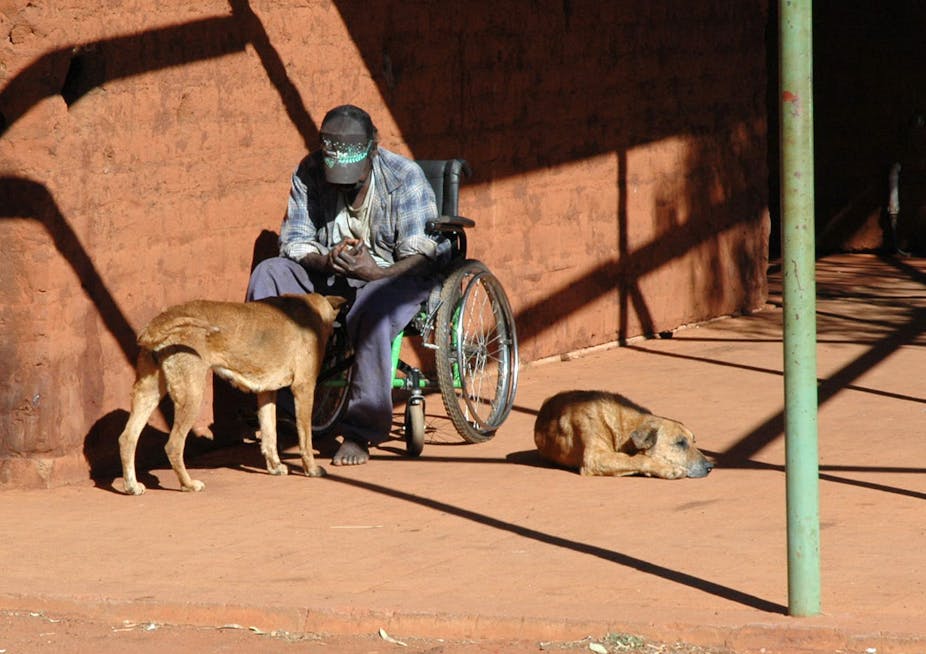Alongside high rates of incarceration, unemployment, homelessness and some of the poorest health outcomes in Australia, Indigenous people’s access and use of disability services is under-representative of the total Aboriginal population.
The high prevalence of disability in the Aboriginal population results from poor social health status and disadvantage that are a legacy of European colonisation and dispossession. Many Aboriginal communities experience inter-generational depression and trauma as a direct consequence of cultural dispossession, racism and social segregation.
Government data shows Aboriginal people are twice as likely to have a core activity limitation as non-Aboriginal people. And they’re more likely to be caring for a person with a disability than non-Aboriginal people.
Earlier this year, the Productivity Commission reported the need for a targeted approach to improve the participation of Aboriginal people in government-funded disability supports and services. As a result, the government is undertaking a number of pilot programs in response to the recommendations of Commission’s report on the Disability Care and Support Scheme.
Current limitations
Disability service providers adopt two common strategies that fail to establish a culturally responsive service system for Aboriginal people.
Firstly, they invest in staff training programs in Aboriginal cultural awareness. This appears to be a positive step, showing that disability service providers acknowledge cultural differences between Aboriginal communities and mainstream community services.
Such programs aim to educate non-Aboriginal workers on Aboriginal cultures, politics and history. But cultural awareness training doesn’t work if the disability service provider is not committed to network and engage with local Aboriginal communities on a regular basis.
Research undertaken by the National Disability Services Association found that some non-Aboriginal workers get caught up in a permanent state of self-consciousness when interacting with Aboriginal people. As a result, non-Aboriginal workers are disinclined to work with Indigenous families as they fear they may offend them.
Second, some disability service providers have undertaken Aboriginal recruitment initiatives to establish a culturally safe environment for Aboriginal people. Research indicates that many Aboriginal people prefer to work with an Aboriginal person than a non-Aboriginal person.
So management committees and staff wrongly assume that placing responsibility for all “Aboriginal matters” and Aboriginal clients onto the Aboriginal workers is culturally respectful. Putting this into practice means non-Aboriginal workers don’t have to engage in Aboriginal communities. And it’s result is that the non-Aboriginal workforce doesn’t learn about local Aboriginal community cultural protocols and practices.
Meanwhile Aboriginal workers develop high workloads and are limited in their career development. The end result is that Aboriginal workers become dissatisfied with their workplace and resign.
These two strategies inevitably fail when used in isolation because there’s limited emphasis on relationship building between disability stakeholders and Aboriginal communities.
The focus on cultural and language differences between Aboriginal and non-Aboriginal communities emphasises such differences and disregards the diversity of cultures and experiences within the Aboriginal population, perpetuating the myth of Aboriginal homogeneity.
Better approaches
Disability stakeholders and Aboriginal communities need to interact at the cultural interface to improve the level of engagement between Aboriginal communities and disability service providers.
The cultural interface is the realm where the trajectories of cultures, histories, beliefs and experiences of both Aboriginal people and non-Aboriginal people intersect, creating tensions and challenges for both cultural groups.
We need to resolve this contestation and tensions to overcome barriers to participation and access for Aboriginal people in the disability service system. The key to this is having Aboriginal communities and disability stakeholders improve communication and relationships under the reforms to the aged care and disability services sector.
One such strategy is creating community interagency forums. This would require stakeholders and Aboriginal communities to establish local networks to identify and address service and program priority areas.
Many disability service providers and Aboriginal communities in New South Wales have developed such networks, which have improved relationships and opened dialogue between the two groups. These networks have undertaken disability awareness campaigns, hosted Aboriginal carer workshops and Aboriginal cultural awareness programs.
The initiatives have helped establish a shared understanding of disability and the benefits in accessing disability services for Aboriginal communities.
Tomorrow (December 3) is International Day of Persons with Disabilities, designated for celebrating and commemorating the successes of the disability rights movement. The theme this year is “Together for a better world for all: including persons with disabilities in development”. Hopefully, it will inspire the sector and the government to make the changes needed to change the fate of Indigenous people with disability.
John Gilroy will be presenting a paper at the World Report on Disability: Implications for Asia and the Pacific Symposium at The University of Sydney on December 5 & 6.

